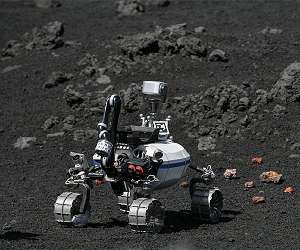Rocket Lab USA, Inc. (Nasdaq: RKLB) has successfully deployed a pathfinding satellite for NASA, setting it on a course to the Moon. The deployment marks the successful completion of Rocket Lab’s first deep space mission, paving the way for the Company’s upcoming interplanetary missions to Mars and Venus.
Owned and operated by Advanced Space on behalf of NASA, the Cislunar Autonomous Positioning System Technology Operations and Navigation Experiment (CAPSTONE) will be the first spacecraft to test the Near Rectilinear Halo Orbit (NRHO) around the Moon. This is the same orbit intended for NASA’s Gateway, a Moon-orbiting outpost that will provide essential support for long-term astronaut lunar missions as part of the Artemis program.
Rocket Lab’s role in the mission took place over two phases. First, CAPSTONE was successfully launched to low Earth orbit by Rocket Lab’s Electron launch vehicle on June 28th. From there, Rocket Lab’s Lunar Photon spacecraft provided in-space transportation, power, and communications to CAPSTONE. After six days of orbit-raising burns by Lunar Photon’s 3D printed HyperCurie engine, CAPSTONE was deployed on its ballistic lunar transfer trajectory to the Moon as planned at 07:18 UTC on July 4th.
The mission was Rocket Lab’s fourth Electron launch this year, demonstrating the rocket’s continued reliability. In addition to providing the launch, Rocket Lab designed, manufactured, and operated the Lunar Photon spacecraft, successfully completing a highly complex deep space mission and demonstrating Rocket Lab’s growing capabilities as an end-to-end space company.
“The CAPSTONE mission marks the beginning of humanity’s return to the Moon through NASA’s Artemis program and we’re incredibly proud that Rocket Lab has played a key role in that,” said Rocket Lab founder and CEO, Peter Beck.
“The Rocket Lab team has been working on CAPSTONE with NASA and our mission partners for more than two years, developing new small satellite technology in the form of the Lunar Photon spacecraft to make this mission possible, so it’s an incredible feeling after all that hard work and innovation to achieve mission success and set CAPSTONE on a course for the Moon.
“This has been Rocket Lab’s most complex mission to date and our team has been incredible. We pushed Electron and Photon to their limits and proved it’s possible to do big missions with small spacecraft. Now we’ll be applying this ground-breaking technology for more interplanetary journeys, including our upcoming missions to Venus and Mars.”
With Rocket Lab’s role in the mission now complete, CAPSTONE’s solo journey to the Moon has begun. CAPSTONE will use its own propulsion and the Sun’s gravity to navigate the rest of the way to the Moon, a four-month journey that will have CAPSTONE arriving to its lunar orbit on November 13, 2022. The gravity-driven track will dramatically reduce the amount of fuel the CubeSat needs to get to the Moon. Advanced Space and Terran Orbital will manage the operation of the CAPSTONE satellite for the duration of its orbital lifespan.
The CAPSTONE mission was Rocket Lab’s 27th Electron launch overall, but it featured several significant technological firsts for the Company, including:
+ First deep space mission.
+ First use of Lunar Photon, a high energy variant of the Rocket Lab-designed and built Photon spacecraft. Rocket Lab previously launched and continues to operate two low Earth orbit variants of the Photon spacecraft.
+ First collaborative mission between Rocket Lab and Advanced Solutions Inc, a Colorado-based flight-software company acquired by Rocket Lab in late 2021.
+ First time using the FR-lite satellite radio which Rocket Lab has an exclusive license agreement with Johns Hopkins University Applied Physics Laboratory to manufacture.
+ First mission where Electron’s second stage deorbited the same day as launch.
+ First mission planning and executing lunar trajectories.
+ At 300 kg (661 lbs) of payload mass, the mission was Electron’s heaviest lift to date.
CAPSTONE was the first in a series of interplanetary missions for Rocket Lab’s Photon spacecraft, including the ESCAPADE mission to Mars in 2024 and Rocket Lab’s upcoming private mission to Venus.
Advanced Space of Colorado, a leading commercial space solutions company, owns the CAPSTONE satellite and operates the mission. CAPSTONE was designed and built by Terran Orbital. CAPSTONE development is supported by NASA’s Space Technology Mission Directorate via the Small Spacecraft Technology Program at NASA’s Ames Research Center in California’s Silicon Valley. Advanced Exploration Systems within NASA’s Human Exploration and Operations Mission Directorate supports the launch and mission operations. NASA’s Launch Services Program at Kennedy Space Center in Florida is responsible for launch management.
Related Links
Rocket Lab
Mars News and Information at MarsDaily.com
Lunar Dreams and more
|
We need your help. The SpaceDaily news network continues to grow but revenues have never been harder to maintain. With the rise of Ad Blockers, and Facebook – our traditional revenue sources via quality network advertising continues to decline. And unlike so many other news sites, we don’t have a paywall – with those annoying usernames and passwords. Our news coverage takes time and effort to publish 365 days a year. If you find our news sites informative and useful then please consider becoming a regular supporter or for now make a one off contribution. |
||
|
SpaceDaily Contributor $5 Billed Once credit card or paypal |
SpaceDaily Monthly Supporter $5 Billed Monthly paypal only |
|

![]()
Robotics team practises lunar exploration on Mount Etna
Berlin, Germany (SPX) Jul 01, 2022
Robots can enter areas that are dangerous for or inaccessible to humans. They can even explore other planets – or the Moon. This has now been demonstrated on Mount Etna, a volcano in Italy. Various robots completed their tasks independently – they took rock samples, analysed them and forwarded the results to their control centre. Two other scenarios were demonstrated in addition to this mission, which was named ‘Geological Mission I’.
These complete the Helmholtz Future Project Autonomous Robotic … read more